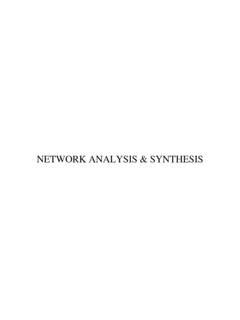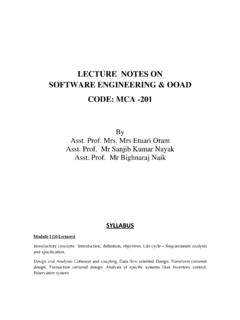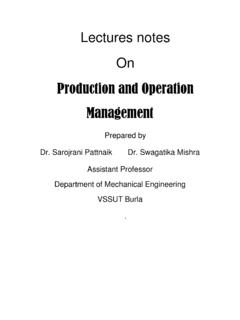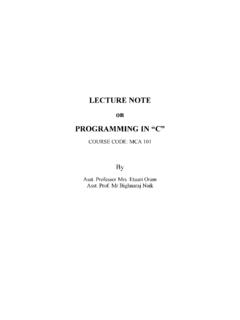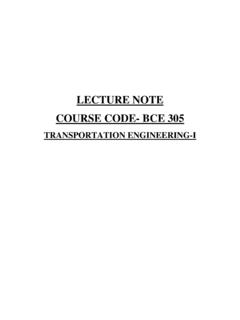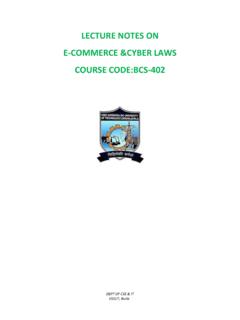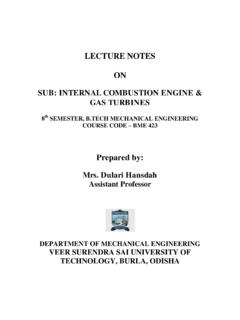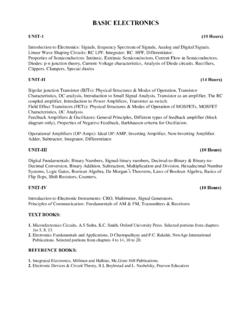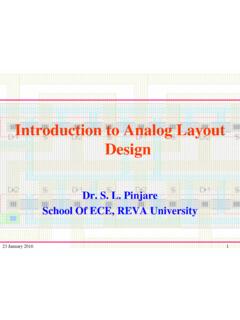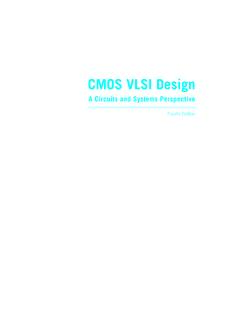Transcription of Lecture Note On Microprocessor and Microcontroller Theory ...
1 Lecture Note On Microprocessor and Microcontroller Theory and Applications Subject Code:BEE-1501 Semester: 5th Branch: EE and EEE Syllabus Disclaimer This document does not claim any originality and cannot be used as a substitute for prescribed textbooks. The information presented here is merely a collection by the committee members for their respective teaching assignments. Various sources as mentioned at the end of the document as well as freely available material from internet were consulted for preparing this document. The ownership of the information lies with the respective authors or institutions. Further, this document is not intended to be used for commercial purpose and the committee members are not accountable for any issues, legal, or otherwise, arising out of this document.
2 The committee members make no representations or warranties with respect to the accuracy or completeness of the contents of this document and specially disclaim any implied warranties of merchantability or fitness for a particular purpose. The committee members shall not be liable for any loss or profit or any other commercial damages, including but not limited to special, incidental, consequential, or other damages. MODULE: 1 1. INTRODUCTION TO Microprocessor AND MICROCOMPUTER ARCHITECTURE: A Microprocessor is a programmable electronics chip that has computing and decision making capabilities similar to central processing unit of a computer. Any Microprocessor -based systems having limited number of resources are called microcomputers.
3 Nowadays, Microprocessor can be seen in almost all types of electronics devices like mobile phones, printers, washing machines etc. Microprocessors are also used in advanced applications like radars, satellites and flights. Due to the rapid advancements in electronic industry and large scale integration of devices results in a significant cost reduction and increase application of microprocessors and their derivatives. Microprocessor -based system Bit: A bit is a single binary digit. Word: A word refers to the basic data size or bit size that can be processed by the arithmetic and logic unit of the processor. A 16-bit binary number is called a word in a 16-bit processor. Bus: A bus is a group of wires/lines that carry similar information. System Bus: The system bus is a group of wires/lines used for communication between the Microprocessor and peripherals.
4 Memory Word: The number of bits that can be stored in a register or memory element is called a memory word. Address Bus: It carries the address, which is a unique binary pattern used to identify a memory location or an I/O port. For example, an eight bit address bus has eight lines and thus it can address 28 = 256 different locations. The locations in hexadecimal format can be written as 00H FFH. Data Bus: The data bus is used to transfer data between memory and processor or between I/O device and processor. For example, an 8-bit processor will generally have an 8-bit data bus and a 16-bit processor will have 16-bit data bus. Control Bus: The control bus carry control signals, which consists of signals for selection of memory or I/O device from the given address, direction of data transfer and synchronization of data transfer in case of slow devices.
5 A typical Microprocessor consists of arithmetic and logic unit (ALU) in association with control unit to process the instruction execution. Almost all the microprocessors are based on the principle of store-program concept. In store-program concept, programs or instructions are sequentially stored in the memory locations that are to be executed. To do any task using a Microprocessor , it is to be programmed by the user. So the programmer must have idea about its internal resources, features and supported instructions. Each Microprocessor has a set of instructions, a list which is provided by the Microprocessor manufacturer. The instruction set of a Microprocessor is provided in two forms: binary machine code and mnemonics. Microprocessor communicates and operates in binary numbers 0 and 1.
6 The set of instructions in the form of binary patterns is called a machine language and it is difficult for us to understand. Therefore, the binary patterns are given abbreviated names, called mnemonics, which forms the assembly language. The conversion of assembly-level language into binary machine-level language is done by using an application called assembler. Technology Used: The semiconductor manufacturing technologies used for chips are: transistor - transistor Logic (TTL) Emitter Coupled Logic (ECL) complementary metal - oxide Semiconductor ( cmos ) Classification of Microprocessors: Based on their specification, application and architecture microprocessors are classified. Based on size of data bus: 4-bit Microprocessor 8-bit Microprocessor 16-bit Microprocessor 32-bit Microprocessor Based on application: General-purpose Microprocessor - used in general computer system and can be used by programmer for any application.
7 Examples, 8085 to Intel Pentium. Microcontroller - Microprocessor with built-in memory and ports and can be programmed for any generic control application. Example, 8051. Special-purpose processors- designed to handle special functions required for an application. Examples, digital signal processors and application-specific integrated circuit (ASIC) chips. Based on architecture: Reduced Instruction Set Computer (RISC) processors Complex Instruction Set Computer (CISC) processors 2. 8085 Microprocessor ARCHITECTURE The 8085 Microprocessor is an 8-bit processor available as a 40-pin IC package and uses +5 V for power. It can run at a maximum frequency of 3 MHz. Its data bus width is 8-bit and address bus width is 16-bit, thus it can address 216 = 64 KB of memory. The internal architecture of 8085 is shown is Fig.
8 2. Fig. 2 Internal Architecture of 8085 Arithmetic and Logic Unit The ALU performs the actual numerical and logical operations such as Addition (ADD), Subtraction (SUB), AND, OR etc. It uses data from memory and from Accumulator to perform operations. The results of the arithmetic and logical operations are stored in the accumulator. Registers The 8085 includes six registers, one accumulator and one flag register, as shown in Fig. 3. In addition, it has two 16-bit registers: stack pointer and program counter. They are briefly described as follows. The 8085 has six general-purpose registers to store 8-bit data; these are identified as B, C, D, E, H and L. they can be combined as register pairs - BC, DE and HL to perform some 16-bit operations. The programmer can use these registers to store or copy data into the register by using data copy instructions.
9 Fig. 3 Register organisation Accumulator The accumulator is an 8-bit register that is a part of ALU. This register is used to store 8-bit data and to perform arithmetic and logical operations. The result of an operation is stored in the accumulator. The accumulator is also identified as register A. Flag register The ALU includes five flip-flops, which are set or reset after an operation according to data condition of the result in the accumulator and other registers. They are called Zero (Z), Carry (CY), Sign (S), Parity (P) and Auxiliary Carry (AC) flags. Their bit positions in the flag register are shown in Fig. 4. The Microprocessor uses these flags to test data conditions. Fig. 4 Flag register For example, after an addition of two numbers, if the result in the accumulator is larger than 8-bit, the flip-flop uses to indicate a carry by setting CY flag to 1.
10 When an arithmetic operation results in zero, Z flag is set to 1. The S flag is just a copy of the bit D7 of the accumulator. A negative number has a 1 in bit D7 and a positive number has a 0 in 2 s complement representation. The AC flag is set to 1, when a carry result from bit D3 and passes to bit D4. The P flag is set to 1, when the result in accumulator contains even number of 1s. Program Counter (PC) This 16-bit register deals with sequencing the execution of instructions. This register is a memory pointer. The Microprocessor uses this register to sequence the execution of the instructions. The function of the program counter is to point to the memory address from which the next byte is to be fetched. When a byte is being fetched, the program counter is automatically incremented by one to point to the next memory location.
